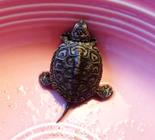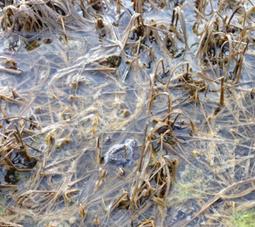I was walking on the beach looking for the first piping plovers of the season, when I looked down. There was a small dark shell with a tiny turtle inside. What to do? I knew it was some kind of land turtle, and I also know they dont live at the beach. The gulls were paying a lot of attention to this inch and a half
 of terrapin who was desperately trying to hide in his little shell. I picked him up and within a few seconds he started squirming and walking from hand to hand as I took him home. I placed him in a bowl and kept his shell wet while I made calls. I just wanted to find out what he was and
of terrapin who was desperately trying to hide in his little shell. I picked him up and within a few seconds he started squirming and walking from hand to hand as I took him home. I placed him in a bowl and kept his shell wet while I made calls. I just wanted to find out what he was and  where to release him.
where to release him.
I am delighted that Harriett Forrester – a terrapin biologist and rehabber – answered my call and gave me directions where to release him. She also told me he was a diamondback and about year old. That he had already gone through a hibernation, so this was a teeny turtle with experience and fortitude. She told me that diamondbacks are tied to salt marshes and this little guy was probably out exploring and got swept away. He may have washed up on the beach or some well-meaning human found him and decided he needed to go into the ocean from which he fled.
Harriet told me he needed to be in a salt marsh far away from humans, and I thought of the perfect spot. Bowl in hand, we sped off and within a few minutes, my diamondback was free from gulls and my pink bowl. And I hope he has found true happiness in salt marsh muck.
 P.S. In watching him for a while I see how he could have been exploring and gotten way off track. He was very curious and surprisingly not shy for a young turtle recently out of hibernation. And, if you find a turtle on land that seems to be out of his element and needing help always check to see if the turtle has feet and claws or flippers. Feet means they live on land, flippers in the sea. Then call an expert like Harriet. I am glad I did as I had a lot of well meaning suggestions for others and every one of them was not the right advice.
P.S. In watching him for a while I see how he could have been exploring and gotten way off track. He was very curious and surprisingly not shy for a young turtle recently out of hibernation. And, if you find a turtle on land that seems to be out of his element and needing help always check to see if the turtle has feet and claws or flippers. Feet means they live on land, flippers in the sea. Then call an expert like Harriet. I am glad I did as I had a lot of well meaning suggestions for others and every one of them was not the right advice.
It’s that time of year when land turtles are nesting, crossing roads to get from the marsh to the beach where they lay their eggs. If you see a turtle crossing the road, before moving her, make sure you are taking her the direction she wants to go! If you don’t want to pick the turtle up, keep traffic away from her until she has finished her crossing. And remember that if you find a turtle that needs help, call a licensed rehabber. They know exactly what to do and it actually is illegal to keep wildlife without a license. So, check out this list and call the right person for the help you need.